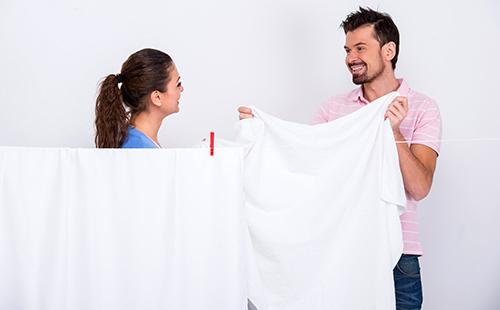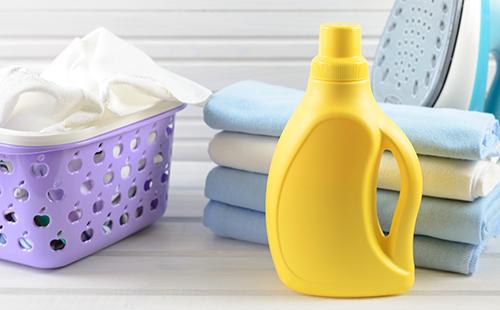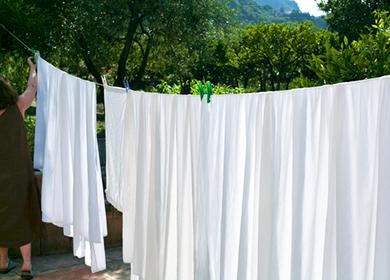The content of the article
Why does the bed turn yellow or grayish? Hard water and powder are to blame. Salt is present in hard water. The interaction of powder elements with them leads to the fact that the fabric loses its snow-white appearance, becomes grayish or yellowish, and washed clothes are obtained. The color of the bed changes if it has been stored in a humid room for a long time. After such storage, the sheets become gray, as if they were never white as snow. Bed linens lose their color even when they are in the same basket for dirty things for a long time: therefore it is not recommended to put off the washing of white sheets in a long drawer (removed - washed).
Snow-white sheets can be returned. Also, a yellowed greasy pillowcase and a snow-white tablecloth are also difficult to immediately put in order and give freshness. You just need to know how. There are many ways to whiten - in the process are improvised products, store bleaches and even the good old boiling, which “carried away” many generations of housewives.
Choose a tool in the store
Store detergents will help to whiten very dirty laundry at home very quickly and efficiently. This method involves minimal time and effort. In the departments of household chemicals, various whitening products are sold: you can choose both a budget and an expensive option. Bleaches are divided into three types:
- optical;
- chlorine based;
- oxygen.
To make a choice, you need to know the features of each type. All means have their pros and cons, but finding an effective and best bleach is a feasible task. The table below will help you decide.
Table - Pros and cons of different types of bleaches
| Bleach type | pros | Minuses |
|---|---|---|
| Optic | - Creates a visual effect "whiter than white"; - can be added when washing in a washing machine; - is in the composition of powders | - Whitening does not actually occur - only a visual effect; - does not cope with spots and pollution |
| Chlorine based | - Affordable whitening agent; - effectively bleaches; - removes pollution; - disinfects | - Thins the fabric, from which the bed spoils; - it is impossible to pour in a "washer" (only a hand wash); - evaporation of caustic compounds provokes respiratory tract irritation; - on contact with the skin causes itching, peeling, allergic reactions |
| Oxygen | - Safe (without chlorine); - whitens effectively and delicately; - can be applied to any type of fabric; - suitable for "washing" | - High price |
When choosing a bleach for linen at home, it is better to give preference to modern household chemicals. Oxygen bleach for clothes is safe, environmentally friendly and copes with the main task of "five plus."As a bonus, it saves time, because most modern products are designed for machine whitening.
Chlorine-containing bleaches are popular “the old fashioned way”: for a long time the housewives had no alternative, and when the choice appeared, many continued to buy the products they were used to. The cost of chlorine-containing bleach also bribes, but the fabric becomes thinner from them, so that in reality only the appearance of economy is created.

Good old ways: boiling and soaking in white
For a long time it was believed that the best way to restore the dazzling purity of bedding is boiling. This method is suitable for cotton and linen sheets and duvet covers. It is still used as an alternative to aggressive chemical bleaches. Boiling will save if you want to remove bedding from yellowness. The downside of the method is that you have to spend time.
You can do without boiling. The second method known to all housewives is soaking in whiteness. Bleach contains chlorine, so be prepared to do it yourself. You can’t add such funds to the machine.
Boil
What is required:
- large capacity (necessarily enameled / galvanized);
- white towel or cloth;
- laundry soap / powder;
- ammonia.
Instruction manual
- Cover the bottom of the selected container with a white cloth.
- Make a soapy solution. If there are “blots” on the sheet, lather them with household soap.
- Send the laundry to the “boil out”. Try to straighten it as much as possible.
- Pour soapy water to cover the laundry.
- Add a tablespoon of ammonia. You can skip this step if there is no contamination on the sheet.
- Boil for about an hour. Be sure to use a wooden stick for stirring.
Soak
What is required:
- basin;
- white;
- powder / laundry soap.
Instruction manual
- Prepare a soap solution using powder or laundry soap.
- Add whiteness: for every 3 l - a tablespoon of the product.
- Soak the bed for 20 minutes.
- Rinse thoroughly by hand.
How to whiten white bedding without extra costs
You can wash the linen from grayness using improvised means. Soda solution, peroxide, potassium permanganate, mustard powder and even vegetable oil - these are the main assistants to the hostess. Folk remedies are easy to use (unlike boiling) and safe in comparison with the use of chlorinated bleaches.
Soda
Features. A versatile, effortless way. After using a soda solution, laundry can be machine washed.
Bleach
- Five tablespoons of soda mixed with half the amount of ammonia.
- Dilute in 5 liters of water.
- Soak the laundry for two hours.
- Wash in a typewriter.
Peroxide
Features. Hydrogen peroxide bleaching is simple. In this case, the tool copes well with dullness. It whitens delicately, so it can be applied to any material.
Bleach
- Prepare a solution of two parts of peroxide and one part of ammonia.
- Dilute the solution with 5 l of warm water.
- Soak the sheets for 40 minutes.
- Rinse.
Mustard
Features. Mustard powder not only bleaches, but also removes fat and disinfects. The method can be applied even to delicate fabrics, for example, silk sheets.
Bleach
- To bleach one sheet, boil 3 liters of water.
- Add three tablespoons of mustard (powder) to the water.
- Settle the mustard solution for two hours.
- Drain the water so that the remaining powder remains at the bottom of the pan.
- In drained water, soak the sheet for 20 minutes.
- Wash.
Potassium permanganate
Features. Manganese bleaching is rarely practiced, all because of the ability of manganese to dye fabrics. Few people know that potassium permanganate perfectly whitens. With it, you can return the whiteness even to long-grayed things. The only negative is that you have to wait.
Bleach
- Rub a 100 gram bar of laundry soap.
- Dissolve the chips in 10 l of boiling water.
- Dilute potassium permanganate in a separate container to a faint red color and combine with a soap solution. The result is a brown liquid.
- Soak the laundry in the solution for six hours. Close the container in which the laundry is soaked with a lid. No cap? Polyethylene will help out.
- After time, wash and marvel at the radiant whiteness.
Sunflower oil
Features. Oil is associated with greasy spots, but if you know what to mix it with, it will help whiten the fabric. A multi-component method is worth trying for those who like to experiment in the household.
Bleach
- Boil a bucket of water.
- Add the ingredients: sunflower oil (two tablespoons), salt and soda (per tablespoon), washing powder - (glass).
- Pour the laundry with the prepared solution and leave for a day.

White kit care tips
With white bedding a lot of trouble, say the mistresses. After a couple of washes, you have to look for a solution on how to return the sheets to shining whiteness. This can be done if you adhere to the following rules.
- Wash correctly. Sort the wash: color and white sheets need to be loaded into the machine separately. Follow the rule, even if you know that colored fabric does not fade: such a neighborhood “eats” the radiant whiteness of the sheet. And wash the bed immediately: dirty sheets, lying in a basket, will turn yellow.
- Rinse well. So that the laundry does not turn yellow, it must be carefully rinsed out. It is advisable to do this first in warm and then in cold water.
- Soften water. If you are actively “exploiting” white bedding, then you often have to wash it. From regular contact with hard water, the fabric turns yellow. Your task is to soften the water. Use powders containing emollients, add soda or vinegar solution to the machine.
- Keep wisely. Before storing the white bedding in the closet, make sure it is completely dry. From moisture, linen becomes gray and smells bad.If you like white bedding, do not equip lockers for storing it in the bathroom. It's too wet here: there is a chance that sending a white sheet to the shelf will take out the gray one. Prevent bedding: regularly remove from the cabinet for ventilation. For prevention of a musty “aroma”, shift the laundry with pieces of soap.
Bleaching bedding at home is not useful if you take the habit of soaking white sheets before going to the typewriter. You can add peroxide to the bowl or a couple of drops of lemon. If there is severe contamination on the duvet cover, detergent for dishes is added to the soaking water.

